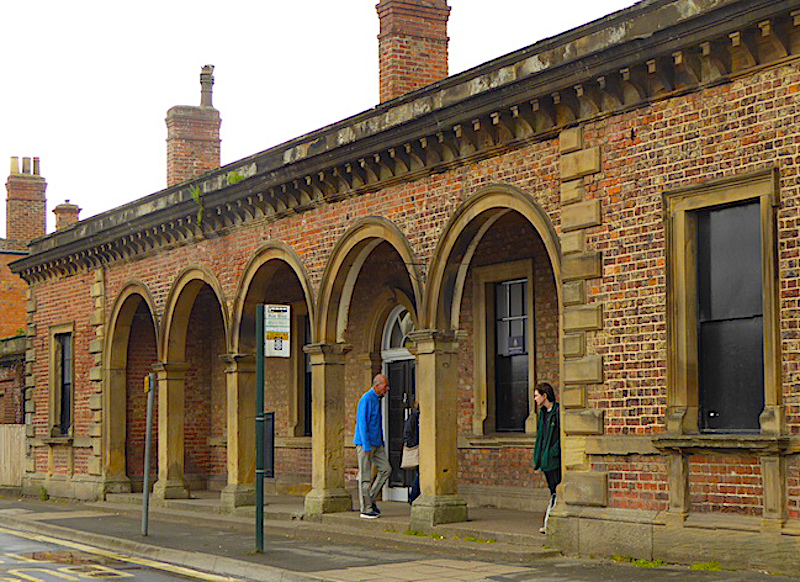
eorge Townsend Andrews (1804-1855), who was born in Exeter, is generally thought of as a railway architect. This is because of his notable work for Sir George Hudson, "The Railway King," in Yorkshire. But, as even Jack Simmons points out in his book on Victorian railways, Andrews also built nine churches in York (34) — moreover these, like the railway buildings themselves, were just part of his substantial and varied output.
Like another northern architect, Henry Francis Lockwood, Andrews trained under the well-known London architect, Peter Frederick Robinson (1776–1858). Made up to a partner, Andrews went to Robinson's York office in 1825, to supervise his work on expanding the County Gaol at the Castle. He soon established himself there, building an office close to the castle and energetically fulfilling other commissions. Although the partnership lasted into the mid-thirties, "other than the work at the Castle and on restoring the medieval city walls, the known output of Robinson & Andrews’ York office during their decade of partnership appears to be from George alone" (Hill).

Once Andrews became involved with Hudson, he did indeed make a name for himself as a railway architect, fulfilling major commissions for the York and North Midland Railway. According to Nikolaus Pevsner and David Neave, Andrews was most at home in the classical style (90), and this is demonstrated, for example, in the elegant De Grey Rooms in St Leonard's Place, and the impressive Yorkshire Insurance Building in St Helen's Square, York. For the latter, especially, this was to be expected: as Pevsner and Neave note, the classical style was still "the norm for commercial buildings until the 1880s" (100). But the railway historian Bill Fawcett reminds us that Andrews was trained during a period "strongly influenced by the cult of the Picturesque, and romantic scenery," and it is not surprising therefore that he produced
Gothic designs for stations and houses. Some are Tudor in character, a more scholarly version of the sort of "Old English" designs published by his mentor, P. F. Robinson, and characterised by mullioned windows and elaborate bargeboards. Others are more sternly Gothic, closer to Pugin, and have windows made up of lancets with trefoil heads, Both types are far more convincing stylistic essays than the little houses of the Newcastle & Carlisle Railway or the Tudor revival of John Green Junior on the GNE [the Great North of England Railway]. [A History of North Eastern Railway Architecture, 62]

As a railway architect, Andrews was so successful that when Hudson became Lord Mayor of York for the third time in 1846-47, he served as Sheriff. It was in many ways a dream partnership. Robert Beaumont writes,
Hudson’s close relationship with George Townsend Andrews, who designed the first York Station at Toft Green, as well as the De Grey Rooms, guaranteed that the north of England has more listed railway buildings than anywhere else in the country outside London. Hudson had the money and the drive, Andrews the intellect and the aesthetic vision. Together they ensured that the railway revolution was not just about blood, sweat, tears and dividends, but about beauty as well. [Ch. 19]
However, a disagreement with Hudson in 1848, and Hudson's own fall from grace, brought a sharp downturn in his fortunes. Andrews was still asked to do work at York station, for instance, but the only big commission was for the hotel there (see Fawcett, George Townsend Andrews 127). Other projects came along, but mostly residential ones, and now he began to lose money in speculation — so much so that by 1852 he had fallen into debt. Fawcett particularly mentions the architect's having to sell his prized art collection, which must have hurt him badly: he had collected, among others, many works by his good friend, the York artist William Etty. Andrews died in 1855, but his prominently located office continued to be used by his successors, of whom Charles Fisher and William Hepper (Fisher & Hepper) seem to be the best known. — Jacqueline Banerjee
Works
- De Grey Rooms, St Leonard's Place, York
- (Former) railway station, Pocklington, with train shed and railway workers cottages
- 31 Castlegate, York (Andrews's office)
- Expansion of the York County Gaol (since demolished)
- Former Poor School added to the Bar Convent, Blossom Street, York
- Former Fire Station in St Andrewgate, York
- Former Yorkshire Insurance Company building, St Helen's Square, York
- York's First Stone Railway Station
Bibliography
Beaumont, Robert. The railway King: A Biography of George Hudson. Kindle ed. London: Headline Publishing, 2016.
Fawcett, Bill. George Townsend Andrews of York: The Railway Architect." York: North Eastern Railway Association, 2011.
_____. A History of North Eastern Railway Architecture: The Pioneers. York: Tork Architectural & York Archaeological Society, & "North Eastern Railway Association, 2001.
Hill, Pat. "George Townsend Andrews (1804-1855)." website">York Civic Trust. Web. 27 September 2022.
Pevsner, Nikolaus, and David Neave. Yorkshire: York and the East Riding. New Haven and London: Yale University Press, 2002.
Simmons, Jack. The Victorian Railway. Pbk ed. London: Thames and Hudson, 1995.
Created 27 September 2022